BiTherm’s News
October 2025
THE EVOLUTION OF STEAM MANAGEMENT
Article published in BDC Magazine (more information at the following link):
https://library.myebook.com/Hub/bdc-333-october-2025/6236/#page/173
September 2025
KUWAIT NATIONAL PETROLEUM COMPANY
BiTherm Group has been awarded the turnkey project for the supply and installation of its intelligent steam traps, based on bithermostatic elements with external adjustment mechanism without service interruption, with its prestigious IoT (Internet of Things) SmartWatchWeb wireless monitoring system, for the steam facilities of Unit 29 at MINA AHMADHI REFINERY in Kuwait.
October 2024
BITHERM EARNS SOLVAY’S TRUST FOR STEAM TRAP MONITORING: OPTIMIZING GLOBAL ENERGY EFFICIENCY
We are proud to announce that Bitherm has been selected by Solvay for an ambitious steam trap monitoring project aimed at reducing steam leaks and cutting CO2 emissions across more than a hundred factories worldwide.
This project represents a key milestone in our international expansion strategy, reaffirming our commitment to sustainability and energy efficiency.
The project is based on wireless monitoring implemented using BiTherm devices with LoRa protocol integrated into a Multitech LoRaWAN network, which guarantees reliable and scalable implementation in complex industrial environments.
We continue to work towards a more efficient and sustainable future!
September 2024
WIRELESS STEAM TRAP WIRELESS MONITORING
LoRaWAN and LTE(NB-IoT) are great choices for steam trap wireless monitoring because they allow for long-range, low-power communication. It’s perfect for large-scale facilities where you need to monitor equipment over vast distances without using much energy.
However, there are limitations of LoRaWAN when dealing with thousands of devices in one location, like a refinery. LoRaWAN is designed for low-power, long-range communication, but it does have a lower bandwidth compared to networks like LTE(NB-IoT). This makes it ideal for transmitting small amounts of data, such as status updates or sensor readings, rather than large data streams.
The key limitation with LoRaWAN in such a dense environment is the risk of network congestion due to the relatively small number of available channels and the duty cycle restrictions. As the number of devices increases, so does the potential for collisions, which can affect the reliability of the system.
In contrast, LTE(NB-IoT) or even private LTE(NB-IoT) networks can handle more data and more devices simultaneously. LTE networks would be more appropriate if you need to transmit larger amounts of data or require real-time monitoring for all devices.
Some solutions for using LoRaWAN in large-scale applications include:
- Spreading devices across multiple gateways: This helps reduce the load on any single gateway and minimize network congestion.
- Hybrid solutions: Combine LoRaWAN with other wireless technologies, like LTE(NB-IoT) or clusters of up to 20 sensor devices using a single LoRaWAN transmitter per cluster, to manage different data types and volumes by reducing up to 20 times the number of required wireless transmitters, which are powered by solar energy (see following two pictures).
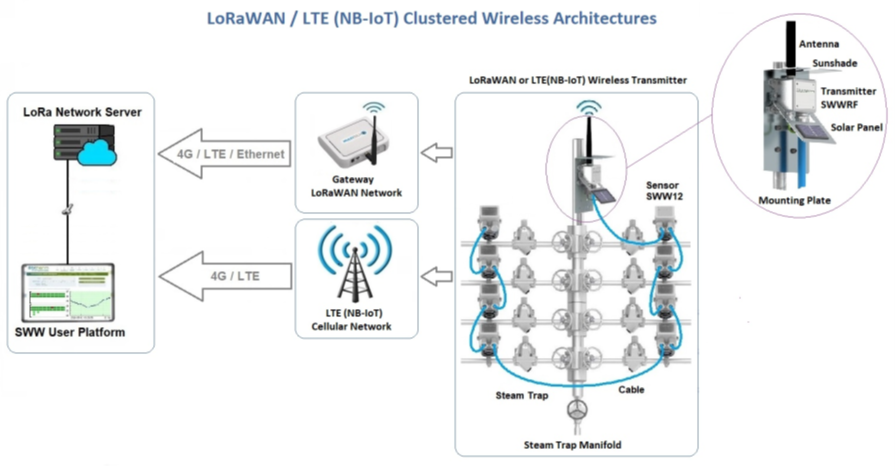
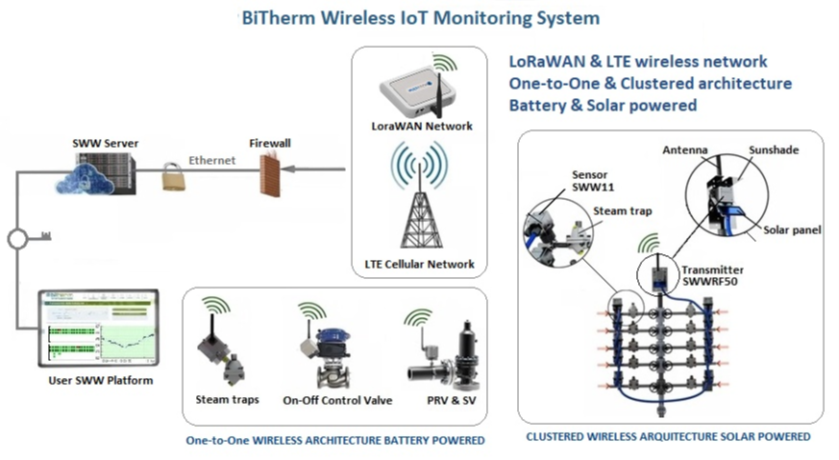
How to save 20% of steam in refineries and petrochemicals
Many refinery operators know that it is possible to increase their profit margins by 2% simply by using steam more intelligently, but they lack the technical means to achieve this goal.
In large-scale steam systems in the oil and gas industry there is enormous potential for savings in steam, CO2 emissions and maintenance costs, especially in steam tracing applications.
Thus, a medium-sized refinery with 10,000 tracing traps, with an average consumption of 30 lbs/hr per trap, consumes about 300,000 lbs/hr of steam in tracing lines.
The following figure shows a tracer line, which is a tracer tubing or small-diameter pipe conduit through which steam flows, that is attached to the outer surface of the main pipe or equipment that needs to be heated.
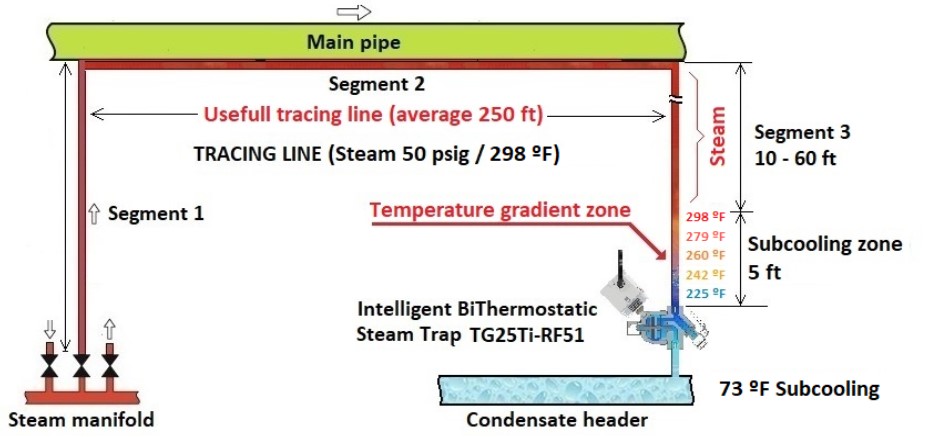
By adjusting the steam trap discharge temperature to 225 ºF (73 ºF subcooling) using intelligent steam traps, 73 BTU/lb of steam can be saved, reducing steam consumption by 8%. This does not affect the effectiveness of the tracing line and provides other important advantages (it avoids pressurization of condensate headers, thermal water hammer and erosion in pipes and accessories) which is why it has now become a practical recommendation for energy efficiency.
Additionally, the intelligent steam trap detects incipient steam leaks in real time, which can be repaired on-line very quickly without interrupting its service. Thus, the intelligent steam traps achieve total steam savings of more than 20%, equivalent to reducing total refining costs by around 2%. BiTherm guarantees these savings in a real way through turnkey projects under the ESCO (Energy Services Companies) business model.
August 2024
BITHERM INTELLIGENT STEAM TRAP
The BiTherm intelligent steam trap combines the excellent performance of the balanced pressure bithermostatic bimetallic steam trap with the patented SmartWatchWeb™ monitoring system.
This advanced intelligent steam trap detects any incident in its normal operation and provides all the necessary elements for its immediate repair without having to interrupt its operation, without replacing the steam trap or any of its components, significantly reducing steam trap maintenance costs (see attached video).
Among other features, this intelligent steam trap allows the energy efficiency of the steam network to be optimized by controlling the condensate discharge temperature to reduce the formation of flash steam in condensate return collectors.
In addition, by detecting internal or external steam leaks and allowing their rapid repair, this intelligent steam trap achieves steam savings of over 20% in large steam networks.
WHY CONDENSATE NETWORKS BECOMES PRESSURIZED?
Answer: It occurs by the presence of steam in condensate return pipes, as the specific volume of steam is enormous compared to the volume of water, and when circulating through pipes sized only for water it pressurizes those pipes.
How does steam get into the condensate network? Obvious answer: due to steam leaks through steam traps, but another less obvious cause is due to flash steam generated by steam trap discharges with excessive residual energy, as explained in the water enthalpy-pressure graph:
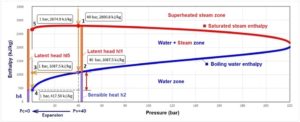
Point 1 represents the energy status of saturated steam at pressure Pv.
When steam transfers its latent heat, it changes to a liquid state (point 2) while maintaining the same temperature as the steam, since during the phase change, the temperature remains constant, although with a much lower energy content. If that condensate is discharged into the return pipe at a lower pressure Pc, its energy status (point 3) is higher than that corresponding to the boiling temperature of water at pressure Pc (point 4). This excess condensate enthalpy (h3 – h4) is reabsorbed by itself in the form of latent heat, meaning part of the liquid changes to a steam status (known as flash steam).
What effects does the pressurization of the condensate network produce?
- It reduces the discharge capacity of steam traps.
- It complicates the recovery of condensates.
- It generates thermal water hammer due to implosion of steam bubbles in the water.
- It generates thermal water hammer due to implosion of steam bubbles in the water.
- It generates significant economic losses.
How is this problem solved?
The most effective and cost-efficient current solution is to use intelligent steam traps (monitored bi-thermostatic steam traps) capable of controlling their discharge temperature (condensate residual energy) to minimize generation of flash steam. This reduces consumption in large steam networks by more than 8%. In addition, intelligent steam traps detect and allow rapid repair of internal or external steam leaks, achieving steam savings over 20%.
BiTherm in the News
Today, we are thrilled to share excellent news about BiTherm, highlighted in the media for our upcoming project at a refinery in Uruguay. Read more here
BiTherm has been selected to implement our advanced monitoring and leak detection solutions for steam traps and valves at a refinery in Uruguay. This project is crucial for improving operational efficiency and safety at the refinery, contributing to a safer and more sustainable environment.
Our involvement in this project includes the installation of our IoT monitoring system, designed to quickly detect any leaks in automatic On-Off valves. This innovative technology will enable the refinery to reduce downtime, minimize maintenance costs, and decrease pollutant emissions.
This achievement reflects our commitment to excellence and innovation in every project we undertake. We are proud that our technology and expertise have been recognized in the media and the industry, and we are excited to begin this project in Uruguay.
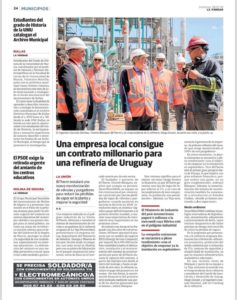
Steam traps for superheated steam
Superheated steam distribution networks only generate condensate during cold start-up of the installation, but once continuous regime conditions are reached, no more condensate is produced in the steam distribution pipes because their temperature is higher than the steam saturation temperature.
Consequently, steam traps for superheated steam networks must quickly remove large quantities of condensate during cold start-up and be able to close hermetically to steam during continuous regime. This behaviour can only be achieved by bimetallic steam traps because they close hermetically when the temperature approaches the steam saturation temperature, but their evacuation capacity is very large during cold start-up and is reduced as their temperature increases, as shown by the flow curves shown in the following figure:
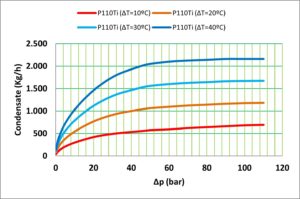
Steam traps of other types are not suitable for superheated steam, as they are not temperature controlled and always lose steam, making them uneconomical.
The life of superheated steam traps is affected by their harsh working conditions, which is why they should always be used with monitoring. The advantage of using monitored bithermostatic steam traps is that they are easy to repair at a very low cost, simply by externally adjusting their operating point when the monitoring system so advises, in order to restore their correct operation without replacing the steam trap.
Energy control of condensate networks
Steam is an excellent thermal carrier, widely used in the industry. As it releases its latent heat, steam condenses, but this condensate still carries residual energy known as sensible heat, which can still be used.
Since a calorie is the energy necessary to heat one gram of water from 14.5 ºC to 15.5 °C at standard atmospheric pressure, the enthalpy curve of boiling water expressed in kcal/kg (blue curve in the graph) coincides practically with the temperature curve of boiling water expressed in ºC (violet curve), which is the steam saturated temperature because the temperature remains constant during the water-steam phase change process.
That means that controlling the temperature of the condensate in ºC is identical to directly controlling the residual energy of the condensate in kcal/kg. Therefore, because thermostatic and bithermostatic steam traps control the temperature of the condensate, they are consequently the only ones capable of directly controlling the residual energy of the condensate and therefore are the most energy efficient.
Any other type of steam trap is operated by parameters other than the residual energy of the condensate (float and inverted bucket traps act by changes in fluid density, thermodynamic traps act by fluid velocity variations, labyrinth or Venturi type traps act by successive expansions of the fluid) but all of them are incapable of controlling the residual energy of the condensate, a fact that generates serious problems of pressurization in condensate return lines, water hammer, etc., what reduce reliability of steam-condensate networks, produce large economic losses and generate significant CO2 emissions.
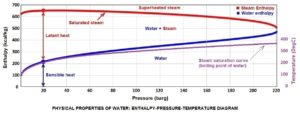
LOCATION OF GAS LEAKS IN AUTOMATIC ON-OFF VALVES
In petrochemical complexes, orange flames in flares confirm the existence of process gas leaks, the location of which is not easy since there are usually a number of valves that discharge to a common flare, as shown in the following diagram:
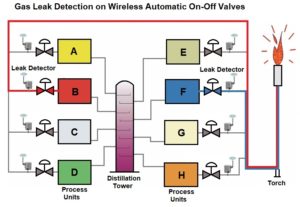
The distillation tower supplies different fractions of process gases to the corresponding Process Units (A, …, H). When an operational failure occurs in any of the Process Units (e.g. B and F) its corresponding automatic valve On-Off discharges these gases to the flare, avoiding stopping the operation of the Distillation Tower, which continues supplying process gases to the other Process Units.
Once the operational problem has been solved in the affected Process Units (B and F), their corresponding automatic On-Off valves close, cutting off the delivery of process gases to the torch.
However, if the automatic On-Off valves lose their tightness, the process gases reach the torch, generating costly process losses and environmental pollution problems.
At BiTherm North America we are pleased to present our non-invasive cutting-edge IoT monitoring system for the rapid detection of dangerous process gas leaks in automatic On-Off valves. This innovative solution offers important economic, environmental and safety benefits.
Find out more at https://bitherm.com/ and take a step towards a safer and more efficient future!
July 2024
Exciting News from BiTherm!
We are thrilled to introduce our cutting-edge IoT monitoring system for rapid detection of hazardous process gas leaks in Pressure Relief Valves (PRV) and Safety Valves (SV). This innovative solution offers significant economic, environmental, and safety benefits:
- Economic Efficiency: minimize costly downtime and maintenance expenses with prompt leak detection.
- Environmental Protection: reduce emissions and protect our planet by identifying and addressing leaks quickly.
- Enhanced Safety: ensure a safer workplace by detecting hazardous leaks in real-time.
Our non-invasive installation process is quick and hassle-free, requiring no additional wireless infrastructure.
Discover more at https://bitherm.com/en/ and take a step towards a safer and more efficient future!

Location and Detection of Gas Leaks.
December 2023
The steam trap monitoring project carried out by BITHERM in the La Rábida Energy Park (CEPSA) won the “enerTIC Awards 2023”. This ambitious project, based on the innovative patented “BiTherm SmartWatchWeb” monitoring technology with LTE wireless protocol (NB-IoT), will reduce their steam consumption by 1,700 Tm/year, with the consequent impact on reducing CO2 emissions, and constitutes the first phase of an ambitious massive monitoring project of steam traps in their Energy Parks, framed in their Positive Motion strategy
See video.
See more details.
BITHERM Revolutionizes Industrial Monitoring with its IoT System Winner of the “enerTIC Awards 2023”
July 2022
BITHERM has been awarded 4 contracts (HYUNDAI, SAIPEM, TECNICAS REUNIDAS and NESMA) to supply around 1,200 wireless steam trap monitoring devices for the new MARJAN GAS PLANT project of SAUDI ARAMCO. Previously, BITHERM has already supplied more than 7,000 steam trap monitoring devices to RAS TANURA REFINERY and JAZAN REFINERY (SAUDI ARAMCO).
November 2021
BITHERM has been awarded a new contract from SAIPEM to supply its Steam Trap Monitoring System (STMS), with ISA100.11a wireless protocol, for the MARJAN project, located in the Arabian Gulf, off Saudi Arabia’s East Coast and is one of the largest oil and gas fields in the region. With this new contract, three SAUDI ARAMCO Petrochemical Complexes (RAS TANURA REFINERY, JAZAN REFINERY and MARJAN ) have placed their trust in the patented SmartWatchWeb™ STMS. Highlight that SmartWatchWeb™ is the most internationally awarded, flexible and powerful STMS currently available on the market.
September 2021
BITHERM has been awarded a new contract with REPSOL for the implementation of SmartWatchWeb Monitoring Technology in steam traps in various Process Units at its Coruña refinery. This contract will be carried out on a turnkey basis under the ESCO business model (financed 100% with the energy savings generated by the project) and its objective is to maximize energy efficiency and reliability of steam networks to reduce atmospheric CO2 emissions.
August 2021
BITHERM has obtained a new contract from HYUNDAI ENGINEERING & CONSTRUCTION Co., Ltd. to supply its Steam Trap Monitoring System (SMTV), with ISA100.11a wireless protocol, for the MARJAN project located in the Persian Gulf, off the east coast of Saudi Arabia and is one of the largest oil and gas fields in the region. With this new contract, three SAUDI ARAMCO Petrochemical Complexes (RAS TANURA REFINERY, JAZAN REFINERY and MARJAN FIELD) have placed their trust in the patented SmartWatchWeb® steam trap monitoring system. Highlight that SmartWatchWeb® is the most internationally awarded, flexible and powerful SMTV currently available on the market.
July 2021
BiTherm obtains a maintenance contract for steam traps and steam traps for all ENDESA’s Thermal Power Plants and Combined Cycles in the Peninsula, the Canary Islands and Melilla. January 2020 BiTherm obtains a maintenance contract for steam traps and steam traps for CEPSA’s Petrochemical Complexes in San Roque and Palos de la Frontera (Huelva).
January 2020
BiTherm obtains a steam trap and steam trap maintenance contract for CEPSA’s Petrochemical Complexes in San Roque and Palos de la Frontera (Huelva).
February 2020
Iberian Lube Base Oil Company, S.A. (ILBOC) won the 2019 ISA100 Wireless Excellence in Automation Award. In doing so, they join a list of distinguished end users including BAPCO, Alcoa, Phillips 66, PETRONAS, NIPPON STEELE and SUMIKIN ENGINEERING.
By winning, ILBOC was chosen from several potential candidates. Their use case was a large-scale ISA100 wireless monitoring system on 904 steam traps and safety valves (possibly the world’s largest current ISA100 installation) by combining multiple applications in a single management platform:
- Reliability and energy saving. Monitoring of steam leaks and energy efficiency in steam traps.
- Fight against climate change. Recovery of atmospheric CO2 emissions.
- Security. Monitoring of dangerous gas leaks in safety valves.
- Employee health and safety. Detection of toxic gases (H2S) in the environment.
- Catastrophic Risk Prevention. Detection of explosive gases (hydrocarbons) in the environment.
The facility also included a one-time contract for Energy Services Company (ESCO) with Bitherm that had NO startup costs . All payments to ILBOC’s Bitherm are based on energy savings.
It is the largest steam trap monitoring project carried out in the world to date using the “ISA100.11a wireless protocol”.
More information in:
See presentation Excellence and Leadership in Wireless Applications ISA100:
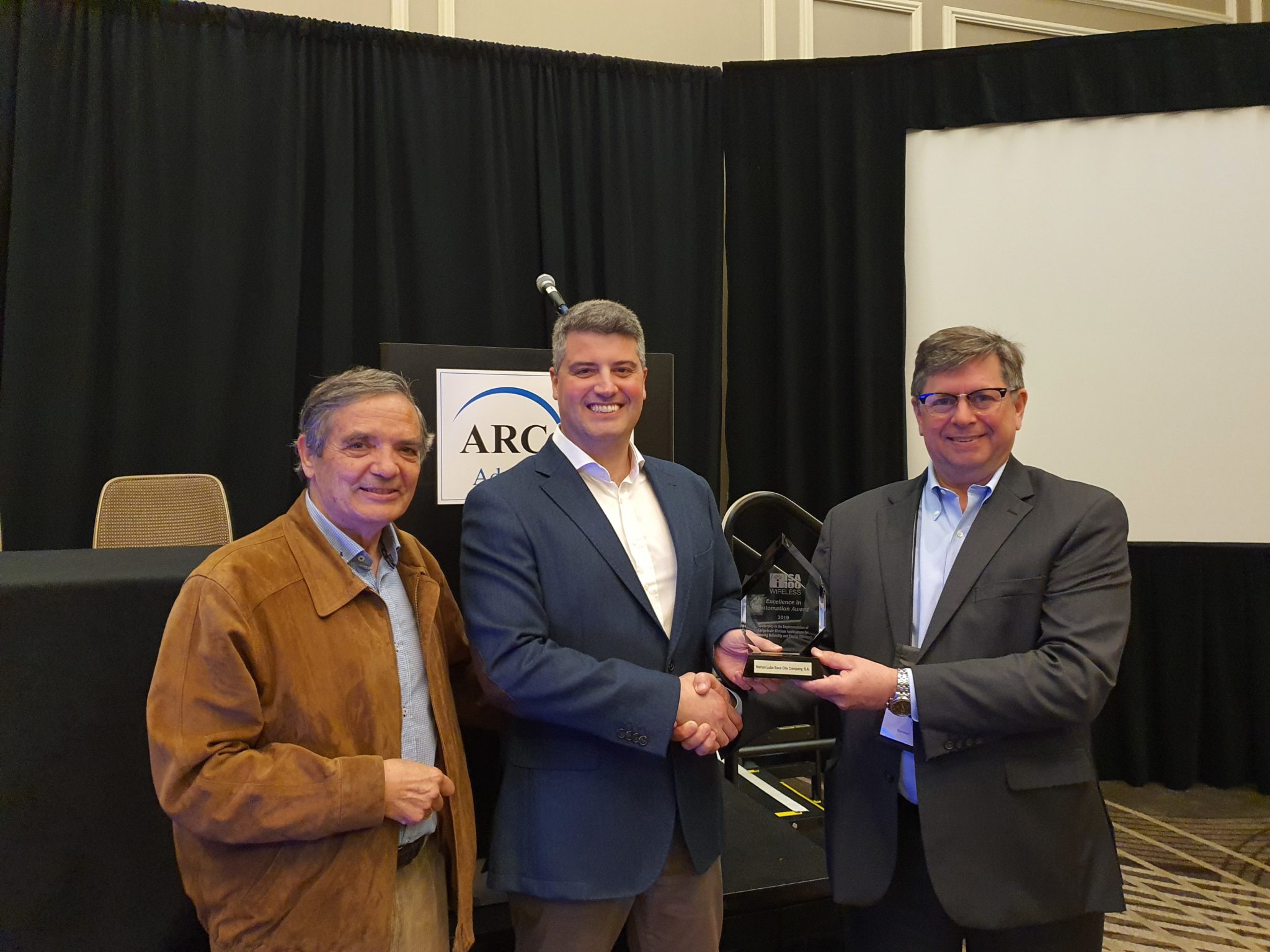
Andre Ristaino, the Managing Director of ISA100 Wireless, presented Mr. Gomez with the ILBOC award at the ARC World Forum. Vicente Blazquez, CEO of Bitherm, also participated in supporting his client, ILBOC.
February 2015
BiTherm obtains ISA100 certification for wireless electronic devices used in its award-winning, innovative and flexible “SmartWatchWeb” monitoring system for steam traps, steam traps and valves.
More information in:
https://www.automation.com/en-us/articles/2016-1/bitherm-wireless-steam-trap-monitor-obtains-isa100
We provide specialized services focused on excellence in energy efficiency of steam networks in the oil refining and petrochemical industry sectors. Our technicians are highly qualified professionals with decades of experience, backed by excellent results.
Visit us
Purgadores de Condensado S.L
Ulises 89, Edifice Bitherm
28043-Madrid(Spain)
Contact us
Phone: +(34) 914 048 087
Fax: + (34) 914 044 875
Email: gestion@bitherm.com